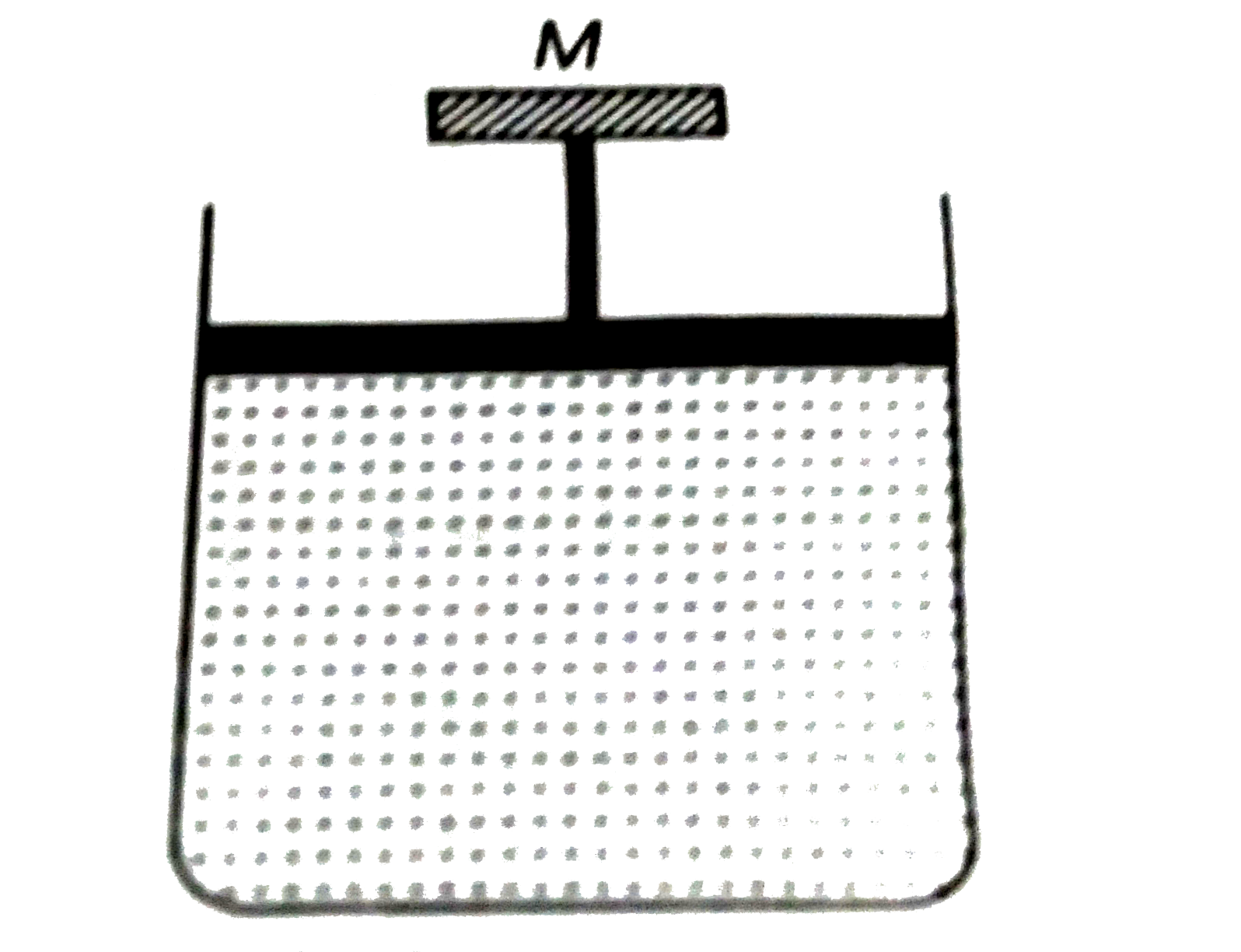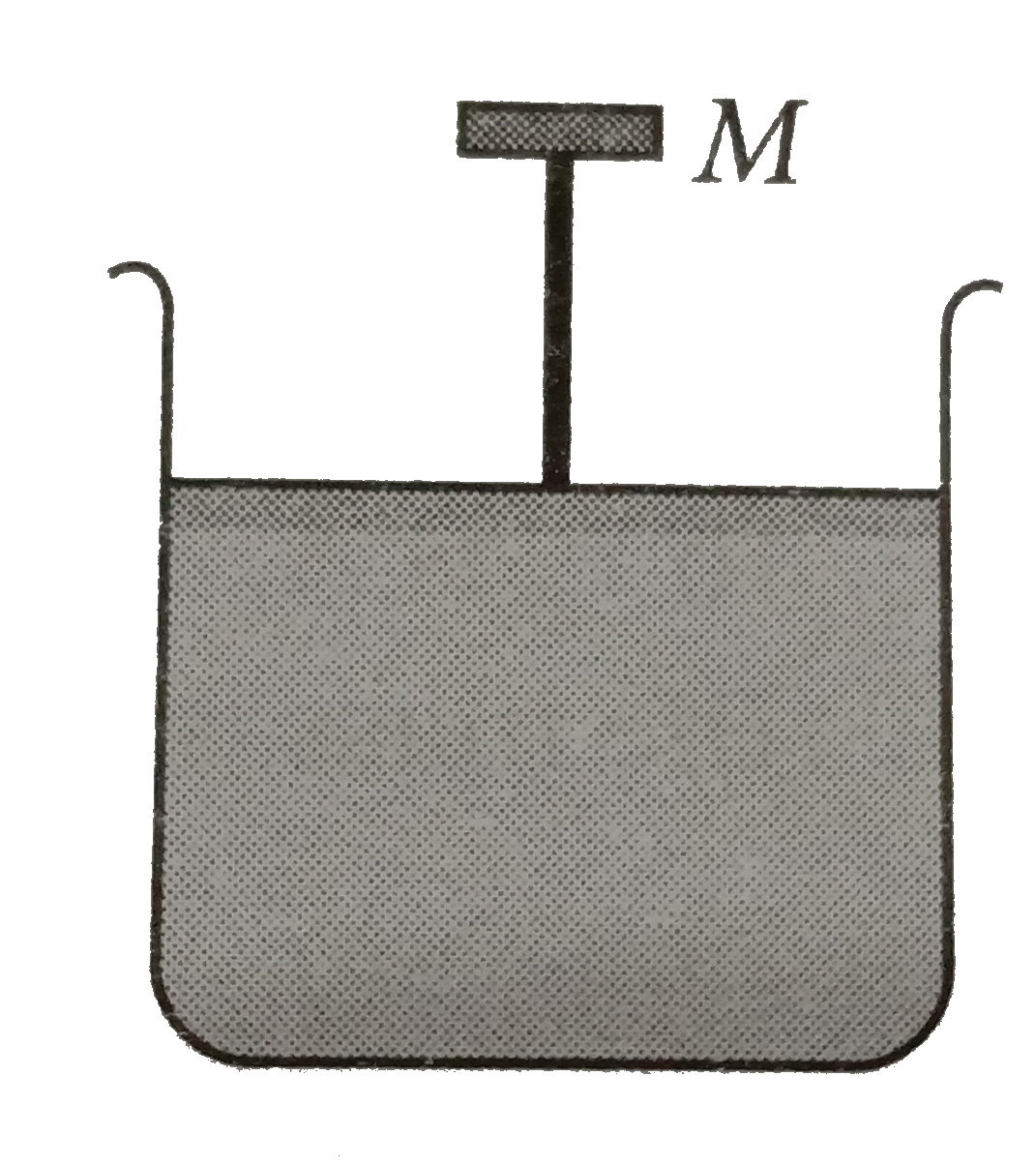A vertical hollow cylinder contains an ideal gas. The gas is enclosed by a 5kg movable piston with an area of cross-section 5×10−3m2. Now, the gas is heated slowly from 300K to 350K and the piston rises by 0.1m. The piston is now clamped at this position and the gas is cooled back to 300K. Fid the difference between the heat energy added during heating process and energy lost during the cooling process. (1atm pressire=105Nm−2]
The correct Answer is:55J
To solve the problem, we need to find the difference between the heat energy added during the heating process and the energy lost during the cooling process of the ideal gas in the vertical hollow cylinder with a movable piston.
1. Identify Given Values:
- Mass of the piston, m=5kg
- Area of cross-section of the piston, A=5×10−3m2
- Initial temperature, T1=300K
- Final temperature, T2=350K
- Displacement of the piston, h=0.1m
- Atmospheric pressure, P0=105N/m2
2. Calculate the Work Done by the Gas:
The work done W by the gas during the heating process when the piston rises can be calculated using the formula:
W=PΔV
where P is the pressure and ΔV is the change in volume.
The change in volume ΔV can be calculated as:
ΔV=A⋅h=(5×10−3m2)⋅(0.1m)=5×10−4m3
3. Calculate the Pressure Acting on the Piston:
The pressure P acting on the piston is the sum of the atmospheric pressure and the pressure due to the weight of the piston:
P=P0+mgA
where g is the acceleration due to gravity (approximately 9.81m/s2).
P=105+(5)(9.81)5×10−3=105+9810=109810N/m2
4. Calculate the Work Done:
Now substituting the values into the work done formula:
W=PΔV=(109810N/m2)(5×10−4m3)=54.905J
5. Determine Heat Energy Added:
Since the process is quasi-static and the internal energy change is zero, the heat added Q during heating is equal to the work done:
Qadded=W=54.905J≈55J
6. Cooling Process:
When the gas is cooled back to 300K, since the piston is clamped, the volume remains constant. Therefore, no work is done during the cooling process, and the energy lost Qlost is equal to the heat removed from the gas, which is also equal to the internal energy change.
7. Calculate the Difference:
Since the work done during heating is equal to the heat added and the work done during cooling is zero:
Difference=Qadded−Qlost=55J−0J=55J
Final Answer:
The difference between the heat energy added during the heating process and the energy lost during the cooling process is 55 J.
- Mass of the piston, m=5kg
- Area of cross-section of the piston, A=5×10−3m2
- Initial temperature, T1=300K
- Final temperature, T2=350K
- Displacement of the piston, h=0.1m
- Atmospheric pressure, P0=105N/m2
The work done W by the gas during the heating process when the piston rises can be calculated using the formula:
W=PΔV
where P is the pressure and ΔV is the change in volume.
ΔV=A⋅h=(5×10−3m2)⋅(0.1m)=5×10−4m3
The pressure P acting on the piston is the sum of the atmospheric pressure and the pressure due to the weight of the piston:
P=P0+mgA
where g is the acceleration due to gravity (approximately 9.81m/s2).
P=105+(5)(9.81)5×10−3=105+9810=109810N/m2
Now substituting the values into the work done formula:
W=PΔV=(109810N/m2)(5×10−4m3)=54.905J
Since the process is quasi-static and the internal energy change is zero, the heat added Q during heating is equal to the work done:
Qadded=W=54.905J≈55J
When the gas is cooled back to 300K, since the piston is clamped, the volume remains constant. Therefore, no work is done during the cooling process, and the energy lost Qlost is equal to the heat removed from the gas, which is also equal to the internal energy change.
Since the work done during heating is equal to the heat added and the work done during cooling is zero:
Difference=Qadded−Qlost=55J−0J=55J
The difference between the heat energy added during the heating process and the energy lost during the cooling process is 55 J.
Topper's Solved these Questions
- BOOK - RESONANCE ENGLISHCHAPTER - KTG & THERMODYNAMICSEXERCISE - Advancel Level Problems1videos
KTG & THERMODYNAMICS
- BOOK - RESONANCE ENGLISHCHAPTER - KINETIC THEORY OF GASES AND THERMODYNAMICSEXERCISE - Exercise64videos
KINETIC THEORY OF GASES AND THERMODYNAMICS
- BOOK - RESONANCE ENGLISHCHAPTER - MAGNETIC FIELD AND FORCESEXERCISE - Exercise64videos
MAGNETIC FIELD AND FORCES
Similar Questions
A cylinder of ideal gas is closed by an 8kg movable piston of area 60cm2. The atmospheric pressure is 100kPa. When the gas is heated form 30∘C to 100∘C, the piston rises 20 cm. The piston is then fastened in the place and the gas is cooled back to 30∘C. If ΔQ1 is the heat added to the gas during heating and ΔQ2 is the heat lost during cooling, find the difference.
View SolutionA cylinder of ideal gas is closed by an 8kg movable piston of area 60cm2. The atmospheric pressure is 100kPa. When the gas is heated form 30∘C to 100∘C, the piston rises 20 cm. The piston is then fastened in the place and the gas is cooled back to 30∘C. If ΔQ1 is the heat added to the gas during heating and ΔQ2 is the heat lost during cooling, find the difference.
View Solution
Knowledge Check
- Question 1 - Select One
A cylinder containing an ideal gas is in vertical position and has a piston of mass M that is able to move up or down without friction (figure). If the temperature is increased
 Aboth P and V of the gas will changeBonly P will increase according to Charle's law.CV will change but not PDP will change but not V
Aboth P and V of the gas will changeBonly P will increase according to Charle's law.CV will change but not PDP will change but not V
When 1.5 mol of a gas is heated at constant volume from 300 K to 350 K and the heat supplied to the gas is 750 J then the correct option is
View SolutionIn a closed vessel, a gas is heated from 300 K to 600 K the kinetic energy becomes/remain
View SolutionN2 gas is heated from 300 kg temperature to 600 k through an isobaric process. Then find the change in the entropy of the gas (n = 1 mole )
View SolutionA cylinder containing an ideal gas is in vertical position and has a piston of mass M that is able to move up or down without friction (figure). If the temperature is increased
 View Solution
View SolutionA cylinder containing an ideal gas is in verticle postion and has a piston of mass M that is able to move up of down without friction. It the temperature is increased,
 View Solution
View SolutionA cylinder containing an ideal gas ( see figure ) and closed by a movable pistong is submerged in an ice- water mixture. The pistone is quickly pushed down from position (1) to position (2)( process AB). The piston is held at position (2) until the gas is again at 0∘C ( processs BC). Then the pistone is slowly raised back to position (1) ( process CA)

Which of the following P−V diagram will correctly represent the processes AB,BC and CA and the cycle ABCA?View SolutionA cylinder containing an ideal gas ( see figure ) and closed by a movable pistong is submerged in an ice- water mixture. The pistone is quickly pushed down from position (1) to position (2)( process AB). The piston is held at position (2) until the gas is again at 0∘C ( processs BC). Then the pistone is slowly raised back to position (1) ( process CA)

Which of the following P−V diagram will correctly represent the processes AB,BC and CA and the cycle ABCA?View Solution

